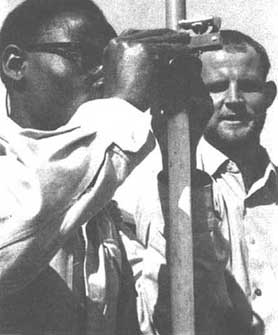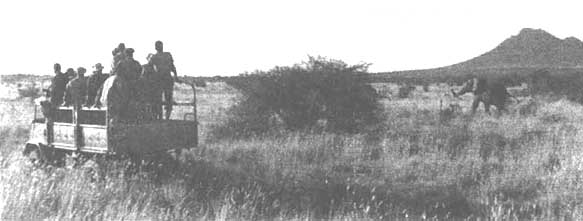FAO picture story
A school for game scouts and park wardens




Africa's wildlife is in the hands of these men. These are the future park wardens and game scouts of Africa. The men who have accepted the duty of caring for one of the most precious resources of their countries.
Africans from ten countries are studying at the College of African Wildlife Management, situated on the slopes of Mount Kilimanjaro in Tanzania. This college is the first of its kind in Africa, where men are being trained as the future leaders in wildlife conservation. Here the students are learning that the great and beautiful birds and beasts of Africa are more valuable than they or their ancestors ever dreamed.
Many people ask why wild animals are so valuable, and why the Food and Agriculture Organization of the United Nations (FAO) for one is helping all over Africa to try and save them.
They can provide meat for the protein-hungry people of Africa. Experiments are proving that certain game animals can be raised like cattle, and can thrive on grasses and bush that cattle would not be able to survive on.
And they are also the prime resource for one of the biggest industries in East Africa - tourism. More and more tourists are coming to Africa to see these unique and magnificent animals living freely in their natural home, the plains and forests. Tourism creates work for Africans in all trades, and this creates income for a whole country, not just a handful of people.
Game parks, protected land where animals and birds can be watched over, are as basic a resource as the animals. The students at the college are learning to care for these parks, conserve precious land and water, knowing how vital these are to keeping wildlife thriving in wild places.
It has been said that 90 percent of Africa's wild animals have been exterminated forever. But the chances of preserving the remaining 10 percent are very high now.
UNDP/FAO project operated by the Forestry and Forest Products Division



Internationalization of forestry associations
In a world in which ever greater facilities in communications lead to increasing exchanges between countries, the internationalization of the activities of groups would. appear to be a natural phenomenon.
Today in the field of forestry international communications can be of two kinds. First there is the commercial exchange of products. Consumption of forest products varies greatly from one country to another and so does their quality. Therefore the uses to which they are put in different parts of the globe are also diverse. Indications are that, in both the short and long term, demand will tend to become more uniform while at the same time increasing. This increase in demand can only be met by an increase in the exchange of forest products, taking into account differences of quality.
In addition, however, there are technical and cultural exchanges. Here again the standards reached in different parts of the world vary greatly. The majority of countries have not yet mastered either the silvicultural techniques or the rational means which will enable them to harvest, as much for themselves as for the rest of the world, the maximum yield from the forests at their disposal while ensuring the conservation of these natural resources. It is the duty of the more developed countries to help the others to acquire this knowledge; this help is already being increasingly given.
Internationalization of the different types of associations which have been analyzed would naturally promote this dual purpose.
Interest in internationalization appears to be the concern of nonprofit-making associations. Even for those whose aims are territorially very limited as, for example, the protection of a huge area of forest, the means they can use to attain these new objectives would obviously be strengthened if they could have the benefit of the strength and prestige of international associations.
The internationalization of profit-making associations would in many cases seem equally useful. Indeed it is a necessity for industrial and commercial groups whose members are directly concerned with the world increase in the production and consumption of the goods they manufacture. It would inaugurate in new fields a continuous exchange of information among national groups concerned with the same problems, whether technical or economic.
But perhaps it is the groups of the third type, especially technical workers in the forests and in wood-using industries, who are most interested in internationalization. The great influence this third group is capable of exercising on forest policy and its implementation has already been stressed. This influence could only be for good because the members of these associations: are just those technicians who are completely conversant with the forest problems of the country, their possible solutions and the obstructions these solutions might encounter. It has also been said that these groups do not make great demands for a better standard of living for their members, owing to high technical ability and the prestige conferred upon them by their studies and the work with which they are entrusted.
All this is quite true, but only given two conditions. First, these groups must really exist, be well organized with clearly defined aims, and be engaged in activities the purpose of which is readily understood. Second, the groups in question must enjoy a satisfactory reputation with the government authorities which they can influence, and these authorities must realize that the advice they are given is for the general well-being of the country - based on mature consideration and a profound understanding of the problems, and not in any way dictated by personal interests.
Now these conditions, though well established in some countries, are by no means to be found in regions where forestry has made only meager progress, the number of graduates is very small, and the idea of an association has hardly been entertained. In such conditions the standard of living of forest graduates, even compared with those in similar disciplines, often leaves much to be desired. This is particularly true of those employed by the State, because the importance of their work is often not sufficiently recognized. Isolated efforts by members of the profession, however distinguished they may be, or by badly organized associations are incapable of improving this state of affairs. In these circumstances, it is useless to talk about the way in which individual members of the profession or small unknown professional associations can bring their influence to bear on the development of forest policy. Yet, in some such countries, schools of forestry are established or are being enlarged. If the living conditions under which members of the profession have to work do not quickly become more attractive, the recruitment of pupils to these schools will be seriously affected. Young graduates must at all events feel themselves supported on leaving school and be given the impression that they can and must play a useful part in the economic development of their country; not that the advice they give and the plans they make will be systematically pigeonholed.
This situation can only be prejudicial to the progress of forest policy. It is obvious, however, that it could be greatly improved by the organization of an International Federation of Associations. This would encourage the formation of new associations on a national scale and would very much enhance the reputation of the young associations which already exist. The methods adopted by the more developed countries would be most useful to them as a model and, in view of the fact that their members were devoting themselves to works of general, national and even worldwide importance, these associations would more easily gain the attention of government circles and also of public opinion.
Under the protection of highly organized associations at the international level, these young associations would moreover soon pass the stage of merely defending the material conditions of their members. While still concerned with the improvement of working conditions in the profession, they could enhance their reputation by demonstrating the importance of the harmonious evolution of forestry programs and the progress of forest policy with the economic and social development of the country as a whole.
There is one difficulty as regards the foundation of international associations which cannot be overlooked. They must have headquarters in one specific country. They thus find themselves subject to the laws and regulations of the country in question. As these laws and regulations are drawn up to fit into the general framework of the institutions of that country, they may be quite unsuitable for an international organization. This obstacle has been recognized by the specialized agencies of the United Nations, particularly by Unesco, and it appears that ways have been planned to minimize the difficulties.
There has in the past been a certain lack of co-operation, and even rivalry, among national forestry associations. As far as is known, there is no national forum where each association can explain its policy and discuss it with other associations whose views could be completely different.
Oddly enough, if a national forum does not exist, there is one at least in principle on an international scale: the World Forestry Congress. This Congress, however, only takes place at long intervals and during the years between it is not represented by any permanent body. Its sessions are very short and discussions have therefore to be limited to the broadest aspects of the evolution of world forestry. In consequence, and although decided upon after much careful consultation, the subjects discussed may appear to some participants to be far removed from anything with which they are concerned.
This need not be so if the groups connected directly or indirectly with forest policy in each country were regularly to exchange information at a national level. They could decide which problems were the most intricate or urgent, and they could discuss among themselves the best means of solving them to the advantage of each group and of the whole country.
Would it be an utopian dream to imagine that, without losing their individuality and without abandoning their own particular aims, these varied groups could form a kind of Federation of Forestry Societies in each country? Their general aim would be the conservation of national forests and the complete utilization of all that the forests can yield, both tangible and intangible, for the benefit of the inhabitants of the country. It is clear that a federation of this sort, able to express views common to all people interested in the forest and its products, would have infinitely more weight with the government departments concerned than isolated groups able to speak only for themselves, and possibly finding themselves at variance with other small groups. Such a federation would not have to be exclusive; it could embrace all the types of associations already dealt with in this paper and even those which are concerned with forest policy only from time to time or only to a small extent. Those associations which are at the moment most isolated - for instance forest workers, despite their importance - would have the chance of alliance with other groups. All are linked by a common bond: the forest itself, its permanence and its utilization under the best possible conditions. This is the basis of and justification for the existence of the associations, no matter how much their interests vary. This bond should be stronger than their differences.
It is not inconceivable that in the end these national federations might unite on a regional and world level with the various agencies of the United Nations and particularly with FAO. Both sides would profit from the union. A world federation of this sort would have other parts to play. As one of its main tasks, it could, for instance, co-operate with the organization and content of future World Forestry Congresses.
In ventures of this kind it is sometimes the first step which is the hardest. On the national level each group, jealous of its individuality, is reluctant to merge itself in a national federation. However, one association must take the necessary initiative. This could be one of the most rewarding activities of societies of professional foresters - associations of graduates in forestry and forest industries. Not to mention the national prestige they would acquire, they appear to be the best qualified for the purpose.
The ideas expressed in the last two sections of this paper are only suggestions. Grouping national forestry associations in each country first into large national federations and then into an international one obviously cannot be carried out in the near future. Perhaps it is an ideal to aim at, because it would not only make it easier for governments to plan and execute their national forest programs, but it would also help to educate the public as to the importance of forestry affairs.
On the other hand, it should be possible in the near future to bring about the internationalization of groups with identical or similar aims in different countries where this does not exist. One can imagine the interest such a step would evoke.
It would appear that the easiest group to internationalize and the one which would have the greatest immediate influence on world forestry would be the associations of professional foresters, composed of graduates in forestry and in the wood-using industries. Such a step would give to the national associations in this category a prestige they might not already have gained and which they need in order to exercise a beneficial influence on economic forestry developments in their own countries.